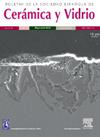通过溶胶-凝胶法获得的 α/β-TCP 硅酸盐玻璃陶瓷:结构和体外生物活性
IF 2.7
4区 材料科学
Q1 MATERIALS SCIENCE, CERAMICS
Boletin de la Sociedad Espanola de Ceramica y Vidrio
Pub Date : 2024-09-01
DOI:10.1016/j.bsecv.2024.04.002
引用次数: 0
摘要
通过溶胶-凝胶法合成了一种 CaO-P2O5-SiO2 系的玻璃陶瓷,其中包含磷酸三钙的两种多晶型变体--白锁石、β-Ca3(PO4)2 和 α-Ca3(PO4)2,热处理温度高达 1200 °C。利用 X 射线衍射分析(XRD)、傅立叶变换红外光谱(FTIR)、扫描电子显微镜和能量色散光谱(SEM-EDS)对玻璃陶瓷的相组成和微观结构进行了研究。在模拟体液(SBF)中对玻璃陶瓷进行了长达 21 天的体外生物活性测试,7 天后,α-Ca3(PO4) 几乎完全溶解在 SBF 中。XRD、傅立叶变换红外光谱、扫描电镜和 EDS 的实验结果清楚地验证了玻璃陶瓷样品在 SBF 环境中能够在其表面形成一层羟基磷灰石。我们还在体外研究了玻璃陶瓷对小鼠骨髓(BM)细胞和前破骨细胞的细胞毒性作用。玻璃陶瓷以剂量依赖的方式降低了骨髓细胞的活力,当浓度低于 0.1 毫克/毫升时,玻璃陶瓷的毒性较低。它对在破骨细胞分化培养基中培养的前破骨细胞的活力影响不大。获得的样品增加了表达破骨细胞生成受体(RANK)和凋亡受体(TRAIL)的前破骨细胞的百分比。总之,在破骨细胞生成的早期阶段,玻璃陶瓷显示出影响前破骨细胞存活/分化的潜力。它可能适用于包括植入物涂层或支架在内的组织工程,因为它可以干扰破骨细胞生成的早期阶段,而破骨细胞生成是生物材料长期应用后进行适当骨重塑和修复所必需的。本文章由计算机程序翻译,如有差异,请以英文原文为准。
α/β-TCP silicate glass-ceramic obtained by sol–gel: Structure and in vitro bioactivity
A glass-ceramic in the CaO–P2O5–SiO2 system, which contains two polymorphic modifications of tricalcium phosphate – whitlockite, β-Ca3(PO4)2 and α-Ca3(PO4)2, has been synthesized by the sol–gel method and thermal treatment up to 1200 °C. The phase composition and microstructure of the glass-ceramic were investigated with X-ray diffraction analysis (XRD), Fourier-transformed infrared spectroscopy (FTIR), scanning electron microscopy and energy dispersive spectroscopy (SEM-EDS). An in vitro bioactivity test of the glass-ceramic in a simulated body fluid (SBF) was conducted for up to 21 days. α-Ca3(PO4) dissolved almost completely in SBF after 7 days. The experimental results of XRD, FTIR, SEM and EDS clearly validated the ability of the glass-ceramic samples to form a layer of hydroxyapatite on their surface in an SBF environment. We also studied the cytotoxic effect of the glass-ceramic on murine bone marrow (BM) cells and pre-osteoclasts in vitro. The glass-ceramic reduced the viability of BM cells in a dose-dependent manner being less toxic at concentrations below 0.1 mg/ml. It modestly affected the viability of pre-osteoclasts cultured in osteoclast differentiation media. The obtained sample increased the percentage of pre-osteoclasts expressing the receptors involved in osteoclastogenesis (RANK) and apoptosis (TRAIL). In conclusion, the glass-ceramic showed the potential to affect the survival/differentiation of pre-osteoclasts at early stage of osteoclastogenesis. It might be suitable for tissue engineering including implants coating or scaffold as it can interfere with early stage of osteoclastogenesis which is required for proper bone remodelling and repair upon a long-term application of biomaterials.
求助全文
通过发布文献求助,成功后即可免费获取论文全文。
去求助
来源期刊

Boletin de la Sociedad Espanola de Ceramica y Vidrio
工程技术-材料科学:硅酸盐
CiteScore
5.50
自引率
2.90%
发文量
72
审稿时长
103 days
期刊介绍:
The Journal of the Spanish Ceramic and Glass Society publishes scientific articles and communications describing original research and reviews relating to ceramic materials and glasses. The main interests are on novel generic science and technology establishing the relationships between synthesis, processing microstructure and properties of materials. Papers may deal with ceramics and glasses included in any of the conventional categories: structural, functional, traditional, composites and cultural heritage. The main objective of the Journal of the Spanish Ceramic and Glass Society is to sustain a high standard research quality by means of appropriate reviewing procedures.
 求助内容:
求助内容: 应助结果提醒方式:
应助结果提醒方式:


